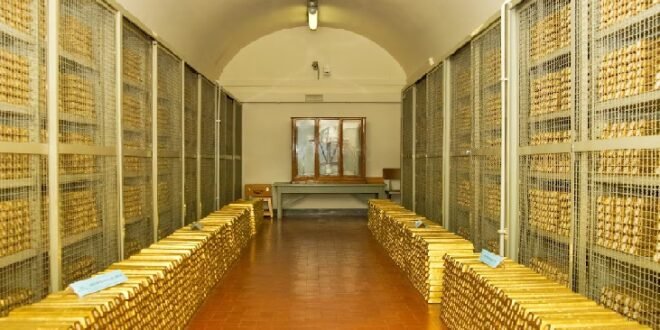17-10-2025
ROME: Italy, whose sovereign assets from bonds to banks have so often been the subject of market crises in recent years, is currently enjoying a windfall as the central bank’s vast gold reserves track record-high prices.
 The country’s bullion stockpile reflects decades of determined safeguarding after it rebuilt reserves plundered by the Nazis in the 1940s, and a stance that has seen it resist calls to sell through repeated crises and as its national debt soared.
The country’s bullion stockpile reflects decades of determined safeguarding after it rebuilt reserves plundered by the Nazis in the 1940s, and a stance that has seen it resist calls to sell through repeated crises and as its national debt soared.
The Bank of Italy now sits on the world’s third-largest national gold stockpile, behind only the US and Germany. Its 2,452 metric tons of gold are worth an estimated $300 billion at current prices, roughly 13% of 2024 national output, media calculations show.
Italy’s love affair with bullion goes back millennia, with the Etruscans mastering the technique of fusing gold beads well before ancient Rome. Under Julius Caesar, the aureus gold coin became the monetary cornerstone of the Roman Empire, and centuries later, the Fiorina became as influential in medieval Europe as the dollar is today.
The country’s more recent gold policy was shaped by its wartime experience, when Nazi forces aided by Italy’s own fascist regime seized 120 tons of its reserves. By the war’s end, these had dwindled to around 20 tons.
During its postwar “economic miracle”, Italy became an export-driven economy and saw a surge in foreign currency inflows, notably US dollars. Some of these, according to the Bank of Italy’s website, were converted into gold.
Its holdings had climbed to 1,400 tons by 1960, including three-quarters of the seized bullion which it was able to recover in 1958.
THE FAMILY SILVERWARE
The oil shocks of the 1970s ushered in further global uncertainty, which in Italy meant social unrest and frequent government changes seen as risky by investors.
“The extreme monetary instability led the central banks of Western countries to buy gold, the ultimate symbol of financial solidity,” Stefano Caselli, dean of the SDA Bocconi School of Management in Milan, told Reuters.
 To offset budget holes left by capital flight, Rome used 41,300 ingots from its gold reserves as collateral for a $2 billion loan from Germany’s Bundesbank in 1976 but unlike Britain or Spain, Italy has refused to sell off gold during financial downturns, retaining its reserves even through the 2008 debt crisis.
To offset budget holes left by capital flight, Rome used 41,300 ingots from its gold reserves as collateral for a $2 billion loan from Germany’s Bundesbank in 1976 but unlike Britain or Spain, Italy has refused to sell off gold during financial downturns, retaining its reserves even through the 2008 debt crisis.
“Gold is like the family silverware, it’s like grandpa’s precious watch, it’s the last resort in times of crisis, any crisis that undermines international confidence in the country,” Salvatore Rossi, former deputy governor of the Bank of Italy, wrote in his 2018 book ‘Oro’ (Gold).
With gold still viewed as a safeguard of last resort by many Western nations, central banks worldwide are again stockpiling amid a reshaping of the global order.
“That historical decision of the Bank of Italy feels strikingly modern,” said Caselli. “Because we are back there again.”
The Bank of Italy currently holds approximately 871,713 gold coins weighing some 4.1 tons in its vaults, dubbed the ‘sacristy’ after the room in a church where sacred items are kept.
Gold accounted for nearly 75% of Italy’s official reserves at the end of last year, a significantly higher ratio than the 66.5% of the euro zone, according to World Gold Council data.
Around 1,100 tons are stored in the vault beneath the Bank of Italy’s headquarters at Palazzo Koch, a short walk from the Colosseum. A similar portion is held in the US, while smaller amounts are kept in Britain and Switzerland. (Int’l News Desk)
 Pressmediaofindia
Pressmediaofindia




